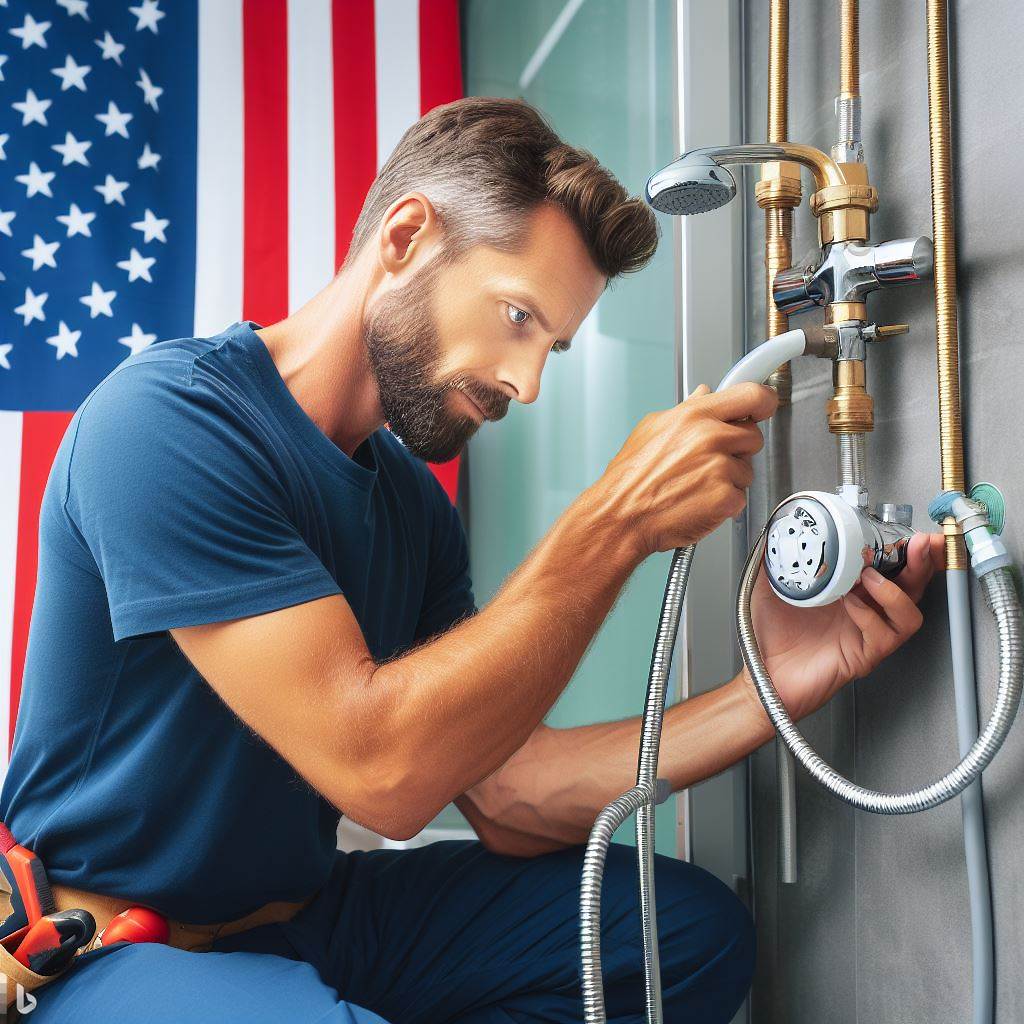Introduction
The environmental impact is crucial as it affects our planet’s health and future.
Now, let’s shift our focus to the trends in the USA.
In today’s world, environmental impact is of utmost importance.
With the increasing concern about climate change and the need to preserve our planet’s resources, it has become necessary to adopt sustainable practices in various industries, including plumbing.
Also known as sustainable plumbing, focuses on reducing water usage and maximizing energy efficiency to minimize the negative impact on the environment.
In the USA, trends have gained significant momentum in recent years.
As water scarcity becomes a pressing issue, sustainable plumbing solutions are being implemented to conserve water and promote responsible water management.
Technologies such as low-flow toilets and showerheads, dual-flush toilets, and water-efficient faucets have emerged as popular options to reduce water consumption in residential and commercial buildings.
Additionally, the use of rainwater harvesting systems has gained traction.
By collecting and storing rainwater for non-potable purposes like irrigation or toilet flushing, these systems reduce the reliance on freshwater sources.
Moreover, the installation of solar hot water systems has become a prevalent trend as it utilizes renewable energy to heat water, reducing the carbon footprint associated with conventional water heating methods.
Furthermore, the use of eco-friendly materials in plumbing systems is gaining importance.
From biodegradable piping materials to environmentally friendly sealants, these alternatives help minimize the environmental impact during installation and maintenance.
Inshort, green plumbing trends in the USA are playing a significant role in mitigating the environmental impact associated with conventional practices.
Through the adoption of water-saving technologies and sustainable materials, these trends contribute to conserving water, reducing energy consumption, and promoting a cleaner, greener future.
Definition of Green Plumbing
Explanation of what green plumbing entails
Green plumbing refers to the use of sustainable and environmentally friendly practices in the industry.
It involves designing, installing, and maintaining plumbing systems that reduce water consumption, conserve energy, and minimize waste.
Green plumbing practices include using low-flow fixtures, such as toilets, faucets, and showerheads, which reduce water usage without sacrificing performance.
Additionally, installing water-efficient appliances like dishwashers and washing machines can further contribute to conserving water.
Incorporating graywater systems is another vital aspect of green plumbing.
Transform Your Career Today
Unlock a personalized career strategy that drives real results. Get tailored advice and a roadmap designed just for you.
Start NowGraywater refers to wastewater from domestic activities like washing machines, showers, and sinks, which can be reused for non-potable purposes such as irrigation or toilet flushing.
By diverting this water from the municipal sewer system, helps to conserve water resources.
Furthermore, promotes the use of sustainable materials.
This includes opting for pipes and fixtures that are made from recycled or renewable materials, such as copper or plastic.
It also involves avoiding harmful chemicals in plumbing products that can contaminate water sources.
Importance of implementing green plumbing practices
Implementing green plumbing practices is crucial for several reasons, including environmental, economic, and health benefits
Environmental benefits
Green plumbing significantly reduces the strain on water resources.
By using low-flow fixtures and graywater systems, substantial amounts of water can be saved.
This helps to conserve natural water sources and protect ecosystems that depend on them.
Conserving water also means reducing the energy required for water treatment and distribution.
Energy-intensive processes like pumping, heating, and treating water contribute to greenhouse gas emissions.
By reducing water consumption, helps to mitigate climate change.
Economic benefits
Implementing green plumbing practices can result in substantial cost savings for both homeowners and businesses.
Using low-flow fixtures and water-efficient appliances helps to lower water bills over time
Additionally, systems often require less maintenance and repair due to their focus on using durable and high-quality materials.
This results in reduced expenses for homeowners and businesses.
Moreover, practices can increase property value.
Buildings with sustainable plumbing features are more attractive to buyers and tenants who prioritize resource conservation and sustainability.
Health benefits
Green plumbing practices prioritize water quality.
Showcase Your Business Today
Reach thousands of readers actively exploring professional services. Publish your business profile and grow your audience now.
Publish NowBy avoiding the use of harmful chemicals in plumbing products, such as lead or phthalates, green plumbing helps to ensure safe and clean drinking wate
Furthermore, proper installation and maintenance of plumbing systems prevent water leakage, mold growth, and sewage backups.
This improves indoor air quality and reduces the risk of waterborne diseases.
In essence, green plumbing encompasses sustainable practices that reduce water consumption, conserve energy, and minimize waste in the plumbing industry.
By using low-flow fixtures, graywater systems, and sustainable materials, green plumbing helps to protect the environment, save costs, and promote public health.
Implementing green plumbing practices is essential to build a sustainable and resilient future.
Read: The Role of Plumbers in Modern US Infrastructure
Water Conservation
Overview of water scarcity issues in the USA
Water scarcity is a pressing issue in the USA due to population growth and climate change.
Green plumbing solutions to reduce water usage
Implementing green plumbing practices can significantly reduce water consumption and contribute to sustainability efforts.
- Low-flow fixtures and faucets
- Low-flow fixtures and faucets reduce water usage by limiting the flow rate without compromising performance.
- Dual-flush toilets
- Dual-flush toilets provide two flushing options, enabling users to conserve water by using a reduced flush for liquid waste.
- Greywater recycling systems
- Greywater recycling systems collect and treat wastewater from non-toilet fixtures, allowing it to be reused for irrigation or toilet flushing.
Water scarcity is a growing concern in the United States, driven by factors such as population growth and climate change.
As the demand for water increases, it becomes crucial to implement sustainable practices to conserve this valuable resource.
Green plumbing solutions offer effective strategies to reduce water usage without compromising daily convenience.
One of the most popular green plumbing practices is the installation of low-flow fixtures and faucets.
These fixtures are designed to limit the flow rate of water while maintaining sufficient pressure and performance.
By using aerators or flow restrictors, low-flow fixtures can significantly decrease water consumption in households, commercial buildings, and industrial facilities.
Such fixtures are commonly used for sinks, showers, and bathtubs.
Dual-flush toilets are another innovative solution to conserve water.
Unlike traditional toilets that use the same flush volume for all waste types, dual-flush toilets offer two flushing options.
A smaller flush is used for liquid waste, while a larger flush is available for solid waste.
This system empowers users to choose the appropriate flush volume, resulting in significant water savings over time.
Greywater recycling systems are gaining popularity as a sustainable method to reduce water waste.
These systems collect and treat wastewater from non-toilet fixtures such as sinks, showers, and laundry.
Once treated, the water can be reused for irrigation purposes or even for flushing toilets.
Greywater recycling not only conserves water but also helps to reduce the burden on wastewater treatment plants.
Implementing green plumbing practices for water conservation is not only beneficial for the environment but also for reducing utility costs.
Many states in the USA now offer incentives and rebates to encourage the adoption of these practices.
Homeowners, businesses, and industries can take advantage of these programs to invest in water-saving technologies and reap long-term benefits.
Basically, water scarcity is a significant issue in the USA, and it is crucial to prioritize water conservation.
Green plumbing solutions such as low-flow fixtures, dual-flush toilets, and greywater recycling systems offer effective methods to reduce water usage while maintaining functionality.
By implementing these practices, individuals and businesses can contribute to sustainability efforts and ensure a healthier future for our planet.
Read:10 Essential Tools Every US Plumber Should Own

Energy Efficiency
Explanation of the energy consumption of plumbing systems
Plumbing systems account for a significant portion of energy consumption in residential and commercial buildings.
Traditional water heaters continuously heat and store water, leading to energy inefficiencies.
Water circulation pumps also consume energy, as they keep water continuously flowing through the pipes.
Green plumbing innovations to improve energy efficiency
Tankless water heaters
Tankless water heaters, also known as on-demand water heaters, are an energy-efficient alternative to traditional water heaters.
These units only heat water when needed, eliminating the standby energy losses associated with traditional models.
They provide hot water instantly and can significantly reduce energy consumption, leading to lower utility bills.
Heat recovery systems
Heat recovery systems capture and reuse the heat generated by drainage water.
This technology transfers heat from wastewater to incoming cold water, preheating it before it enters the traditional water heater.
By recycling thermal energy that would otherwise be wasted, heat recovery systems improve overall energy efficiency.
Showcase Your Business Today
Reach thousands of readers actively exploring professional services. Publish your business profile and grow your audience now.
Publish NowSolar-powered water heaters
Solar-powered water heaters utilize solar energy to heat water, reducing reliance on electricity or gas.
These systems consist of solar collectors that absorb sunlight and transfer the captured heat to a storage tank.
By harnessing renewable energy, solar-powered water heaters significantly decrease energy consumption and greenhouse gas emissions.
Implementing these green plumbing innovations not only benefits the environment but also provides cost savings for users.
These energy-efficient technologies contribute to the overall sustainability of buildings by reducing carbon footprints.
By embracing these green plumbing trends, individuals and businesses can actively participate in environmental conservation.
Essentially, energy efficiency is a paramount consideration in plumbing systems to reduce environmental impact.
Understanding the energy consumption associated with traditional plumbing methods is essential in driving change.
Green plumbing innovations, such as tankless water heaters, heat recovery systems, and solar-powered water heaters, offer effective solutions.
By adopting these technologies, buildings can achieve significant energy savings, lower utility bills, and contribute to a greener future.
Read: US Plumber Salary: A Comprehensive Breakdown by State
Reduction of Chemical Usage
Impacts of chemical usage in traditional plumbing
Chemical usage in traditional plumbing systems has significant impacts on the environment.
- Chemicals used in cleaning and maintenance can contaminate water sources and harm aquatic life.
- Harmful fumes from chemical cleaners can contribute to air pollution and affect human health.
- Chemical waste from plumbing systems can seep into the soil, polluting groundwater and harming ecosystems.
Green plumbing alternatives
To address the negative impacts of chemical usage, green plumbing alternatives have gained popularity.
1. Water filtration systems
- Water filtration systems remove impurities and reduce the need for chemical water treatments.
- By providing clean and safe water, they eliminate the use of harmful disinfectants and purifiers.
- This reduces chemical pollution in water sources and ensures healthier plumbing practices.
2. Eco-friendly pipe materials
- Green plumbing promotes the use of eco-friendly and sustainable pipe materials like PEX and HDPE.
- These materials do not require chemical coatings or treatments, minimizing environmental impact.
- Additionally, they have a longer lifespan and reduce the need for frequent repairs or replacements.
3. Non-toxic drain cleaners
- Traditional drain cleaners often contain harsh chemicals that pose risks to human health and the environment.
- Green alternatives like enzymatic drain cleaners use natural enzymes to break down clogs and stains.
- By avoiding the use of toxic chemicals, these cleaners prevent water pollution and protect ecosystems.
By adopting green plumbing alternatives, we can reduce chemical usage and mitigate environmental impact.
Water filtration systems, eco-friendly pipe materials, and non-toxic drain cleaners offer practical solutions.
These alternatives prioritize sustainability, promoting a healthier and more eco-conscious approach to plumbing.
Green plumbing practices not only benefit the environment but also contribute to the well-being of individuals and communities.
In summary, reducing chemical usage in plumbing systems is crucial for minimizing environmental impact.
Traditional plumbing practices often rely on harmful chemicals that negatively affect water sources and ecosystems.
However, green plumbing alternatives such as water filtration systems, eco-friendly pipe materials, and non-toxic drain cleaners offer more sustainable solutions.
By adopting these practices, we can protect the environment, promote health, and create a more sustainable future.
Health and Indoor Air Quality
Discussion on the potential health risks associated with plumbing materials and practices
Plumbing materials and practices can pose potential health risks due to various factors.
- Corrosion: Old plumbing systems made of lead or galvanized steel can corrode, leading to contamination of water with heavy metals like lead and toxins.
- Leaks: Water leaks can result in the growth of mold and mildew, which can trigger respiratory problems and allergies.
- Waterborne pathogens: Inadequate plumbing systems can harbor harmful bacteria like Legionella, leading to diseases like Legionnaires’ disease.
- Chemical contaminants: Certain plumbing materials contain chemicals, such as polyvinyl chloride (PVC) pipes, which can release volatile organic compounds (VOCs) that are hazardous to health.
Green plumbing options for better indoor air quality
To improve indoor air quality and reduce health risks, green plumbing offers several options:
- Lead-free plumbing fixtures: Opt for fixtures that are certified as lead-free, such as faucets, showerheads, and valves, to prevent lead contamination in your water supply.
- VOC-free pipe insulation: Choose pipe insulation materials that are free from volatile organic compounds to minimize the release of harmful chemicals into the air.
- Proper ventilation systems: Install effective ventilation systems, such as exhaust fans or air purifiers, to ensure proper air circulation and remove pollutants from indoor spaces.
- Filtration and water treatment: Consider installing water filtration systems or employing water treatment techniques to remove contaminants and improve water quality.
- Sustainable materials: Use environmentally friendly plumbing materials like copper or stainless steel pipes instead of PVC, which can release harmful VOCs.
- Regular maintenance: Conduct regular inspections and maintenance to detect any leaks, identify potential issues, and prevent the growth of mold or bacteria in the plumbing system.
- Education and awareness: Stay informed about the potential health risks associated with plumbing materials and practices. Educate yourself and others about the importance of green plumbing for better indoor air quality.
By adopting green plumbing practices and choosing eco-friendly materials, individuals can minimize exposure to harmful substances, promote healthier indoor environments, and contribute to overall environmental sustainability.
Remember, your health and the quality of your indoor air depend on the choices you make.
Read: Historical Evolution of Plumbing in America
The Role of Green Plumbing in Sustainable Construction
Integration of green plumbing into green building certifications
- Green plumbing practices are now recognized as an essential component of sustainable construction.
- Organizations such as the U.S. Green Building Council (USGBC) have incorporated green plumbing into their certification programs.
- LEED (Leadership in Energy and Environmental Design) certification, for example, gives credits to projects that implement water-efficient plumbing systems.
- This integration ensures that sustainable construction projects consider the environmental impact of plumbing systems.
- By including green plumbing in certifications, there is a greater focus on reducing water consumption and promoting sustainable practices.
Benefits of incorporating green plumbing in sustainable construction projects
- Water conservation: Green plumbing reduces water consumption through the use of efficient fixtures and systems.
- Energy savings: By using energy-efficient plumbing systems, there is a reduction in energy consumption.
- Cost savings: Green plumbing can result in lower water and energy bills for both homeowners and commercial building owners.
- Reduced environmental impact: By minimizing water and energy use, green plumbing helps preserve natural resources and reduces greenhouse gas emissions.
- Improved indoor air quality: Green plumbing systems reduce the risk of contaminants entering the building’s water supply, promoting healthier indoor environments.
- Enhanced market value: Buildings with green plumbing features are more attractive to environmentally conscious buyers and tenants.
- Regulatory compliance: Incorporating green plumbing ensures compliance with emerging environmental regulations.
- Long-term sustainability: Green plumbing contributes to the long-term sustainability of buildings, reducing their ecological footprint.
- Water resilience: Green plumbing practices, such as rainwater harvesting and graywater reuse, enhance water resilience during droughts and water scarcity.
- Innovation and technological advancements: Green plumbing drives innovation and the development of more efficient plumbing technologies.
The integration of green plumbing into sustainable construction has become crucial for minimizing the environmental impact of buildings.
Green plumbing practices not only reduce water and energy consumption but also offer a range of benefits such as cost savings, improved indoor air quality, and increased market value.
By incorporating green plumbing into green building certifications, building projects are encouraged to prioritize sustainability and take responsibility for their ecological footprint.
To create a more sustainable future, it is essential to recognize the role of green plumbing in sustainable construction and embrace its benefits.
Conclusion
This blog post has explored various green plumbing trends that are making a significant impact in the USA.
Firstly, the use of low-flow fixtures such as toilets, faucets, and showerheads has proven to conserve water and reduce overall water consumption.
Secondly, the implementation of greywater systems has gained popularity as a sustainable solution for reusing non-potable water from sources like sinks and showers for irrigation purposes.
Furthermore, the adoption of tankless water heaters and energy-efficient appliances in homes has helped reduce energy consumption and lower utility bills.
It is crucial for individuals to recognize the importance of green plumbing practices and take action on implementing them in their homes.
By making simple changes like installing low-flow fixtures and using greywater systems, we can all contribute to the conservation of water resources and the protection of the environment.
As we look towards the future, green plumbing will continue to play a vital role in sustainable living.
With advancements in technology and increased awareness about environmental issues, we can expect to see more innovative solutions in the field of green plumbing.
It is up to us to embrace these practices and make a positive impact on our planet.
By choosing green plumbing, we not only save money but also contribute to a healthier and more sustainable future for generations to come.
[E-Books for Sale]
The Big Book of 500 High-Paying Jobs in America: Unlock Your Earning Potential
$19.99 • 500 High-Paying Jobs • 330 pages
Explore 500 high-paying jobs in America and learn how to boost your career, earn more, and achieve success!
See All 500 High-Paying Jobs of this E-Book
1001 Professions Without a Degree: High-Paying American Jobs You Can Start Now
$19.99 • 1001 Professions Without a Degree • 174 pages
Discover 1001 high-paying jobs without a degree! Unlock career tips, skills, and success strategies for just $19.99!




